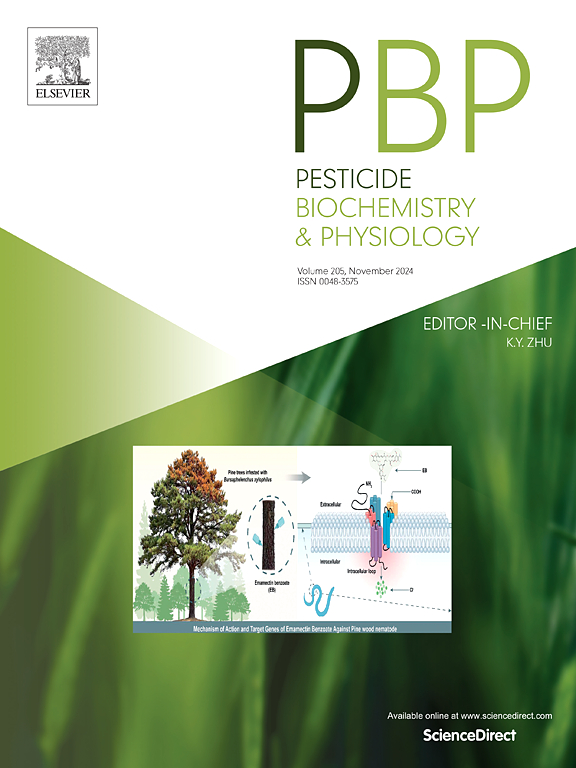Characterization of Caenorhabditis elegans transient receptor potential vanilloid (TRPV) channels and their interactions with insecticidal compounds
IF 4.2
1区 农林科学
Q2 BIOCHEMISTRY & MOLECULAR BIOLOGY
引用次数: 0
Abstract
A number of insecticidal compounds have been found to affect the insect transient receptor potential vanilloid (TRPV) channel. As this receptor is also found in nematodes, we investigated whether these compounds could also interact with the Caenorhabditis elegans TRPV channel in order to explore the possibility of leveraging this target for nematicide development. Here we report on the characterization of C. elegans TRPV channels using electrophysiology and radioligand binding. Evidence of channel activation is demonstrated for OSM9:OCR1, OSM9:OCR2, and OSM9:OCR4 with the natural agonist, nicotinamide. Additionally, insecticides (pymetrozine and pyrifluquinazon – IRAC group 9) known to be insect TRPV agonists were evaluated for nematode TRPV channel modulation. While activation of the nematode channel was not observed, a novel antagonistic blocking effect was discovered. Specificity of this modulation is confirmed by testing the active metabolite (4-trifluoromethylnicotinamide) of a different class of insecticide, flonicamid(IRAC group 29), known to be a non-TRPV chordotonal modulator. We also report competitive binding data for nicotinamide (Ki = 0.13 μM), pymetrozine (Ki = 0.51 μM), and pyrifluquinazon (Ki = 27.3 μM) with [3H]-nicotinamide, demonstrating that they are likely to share a binding pocket on the TRPV channel. These data suggest TRPV may also be a novel target for nematicide development.
秀丽隐杆线虫瞬时受体电位香兰素通道的表征及其与杀虫化合物的相互作用
许多杀虫化合物已被发现影响昆虫瞬时受体电位香兰素(TRPV)通道。由于该受体也存在于线虫中,我们研究了这些化合物是否也可以与秀丽隐杆线虫的TRPV通道相互作用,以探索利用该靶点开发杀线虫剂的可能性。在这里,我们报告了秀丽隐杆线虫TRPV通道的特性,利用电生理学和放射性配体结合。在天然激动剂烟酰胺的作用下,OSM9:OCR1、OSM9:OCR2和OSM9:OCR4的通道被激活。此外,已知的昆虫TRPV激动剂(pymetrozine和pyrifluquinazon - IRAC第9组)对线虫TRPV通道调节进行了评估。虽然没有观察到线虫通道的激活,但发现了一种新的拮抗阻断效应。这种调节的特异性通过测试另一类杀虫剂氟硝酰胺(IRAC第29组)的活性代谢物(4-三氟甲基烟酰胺)得到证实,氟硝酰胺是一种非trpv chordoonal调节剂。我们还报道了烟酰胺(Ki = 0.13 μM)、吡吡嗪(Ki = 0.51 μM)和吡氟喹酮(Ki = 27.3 μM)与[3H]-烟酰胺的竞争性结合数据,表明它们可能在TRPV通道上共享一个结合口袋。这些数据表明,TRPV也可能是杀线虫剂开发的新靶点。
本文章由计算机程序翻译,如有差异,请以英文原文为准。
求助全文
约1分钟内获得全文
求助全文
来源期刊
CiteScore
7.00
自引率
8.50%
发文量
238
审稿时长
4.2 months
期刊介绍:
Pesticide Biochemistry and Physiology publishes original scientific articles pertaining to the mode of action of plant protection agents such as insecticides, fungicides, herbicides, and similar compounds, including nonlethal pest control agents, biosynthesis of pheromones, hormones, and plant resistance agents. Manuscripts may include a biochemical, physiological, or molecular study for an understanding of comparative toxicology or selective toxicity of both target and nontarget organisms. Particular interest will be given to studies on the molecular biology of pest control, toxicology, and pesticide resistance.
Research Areas Emphasized Include the Biochemistry and Physiology of:
• Comparative toxicity
• Mode of action
• Pathophysiology
• Plant growth regulators
• Resistance
• Other effects of pesticides on both parasites and hosts.

 求助内容:
求助内容: 应助结果提醒方式:
应助结果提醒方式:


